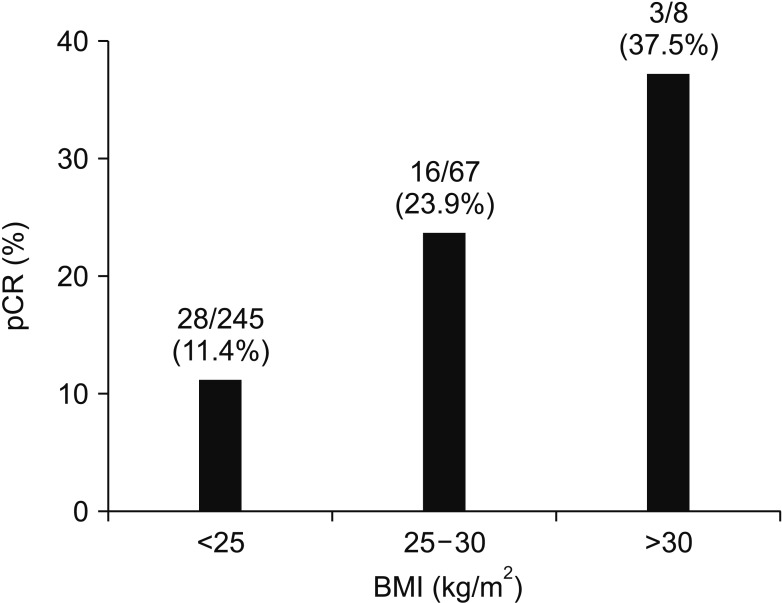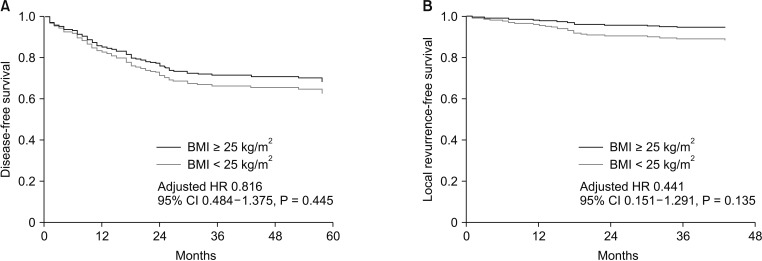Ann Surg Treat Res.
2019 Mar;96(3):116-122. 10.4174/astr.2019.96.3.116.
Obesity as an independent predictive factor for pathologic complete response after neoadjuvant chemoradiation in rectal cancer
- Affiliations
-
- 1Department of Surgery, Chonnam National University Hwasun Hospital, Chonnam National University Medical School, Hwasun, Korea. drkhr@chonnam.ac.kr
- 2Department of Surgery, Chonnam National University Hospital, Chonnam National University Medical School, Gwangju, Korea.
- KMID: 2438687
- DOI: http://doi.org/10.4174/astr.2019.96.3.116
Abstract
- PURPOSE
The predictive role of obesity on pathologic complete response (pCR) after neoadjuvant chemoradiation (nCRT) in rectal cancer remains controversial. This study aimed to evaluate the association between obesity and pathologic response in patients with rectal cancer following nCRT.
METHODS
A total of 320 patients with primary rectal cancer who underwent curative resection after nCRT between January 2010 and September 2014 were enrolled in this study. Obesity was defined as body mass index of ≥25 kg/m2. Clinicopathologic characteristics were analyzed to identify independent predictive factors for pCR.
RESULTS
Among the included patients, 23.4% (n = 75) were obese, and 14.7% (n = 47) showed pCR. Baseline characteristics were generally similar between obese and nonobese patients, except that women (P = 0.001) and cT2 tumors (P = 0.001) were more common in the obese group. Multivariate logistic regression analysis revealed that obesity (odds ratio [OR] = 2.051; 95% confidence interval [CI], 1.009-4.168), cT2 (OR, 3.614; 95% CI, 1.166-11.202), and pretreatment carcinoembryonic antigen <5 ng/mL (OR, 2.921; 95% CI, 1.365-6.253) were independent predictors for pCR. Obesity was not associated with disease-free survival or local recurrence-free survival.
CONCLUSION
Obesity was an independent predictive factor for pCR following nCRT in rectal cancer, but was not associated with recurrence. Further studies are needed to clarify the association between obesity and prognosis of rectal cancer after nCRT.
Keyword
MeSH Terms
Figure
Reference
-
1. National Comprehensive Cancer Network. Rectal cancer clinical practice guidelines in oncology [Internet]. Fort Wathington (PA): National Comprehensive Cancer Network;c2018. cited 2018 May 1. Available from: http://www.nccn.org/professionals/physician_gls/pdf/rectal.pdf.2. Glimelius B, Tiret E, Cervantes A, Arnold D. ESMO Guidelines Working Group. Rectal cancer: ESMO Clinical Practice Guidelines for diagnosis, treatment and follow-up. Ann Oncol. 2013; 24(Suppl 6):vi81–vi88. PMID: 24078665.
Article3. Sauer R, Becker H, Hohenberger W, Rodel C, Wittekind C, Fietkau R, et al. Preoperative versus postoperative chemoradiotherapy for rectal cancer. N Engl J Med. 2004; 351:1731–1740. PMID: 15496622.
Article4. Gerard JP, Chapet O, Nemoz C, Hartweig J, Romestaing P, Coquard R, et al. Improved sphincter preservation in low rectal cancer with high-dose preoperative radiotherapy: the lyon R96-02 randomized trial. J Clin Oncol. 2004; 22:2404–2409. PMID: 15197202.
Article5. Martin ST, Heneghan HM, Winter DC. Systematic review and meta-analysis of outcomes following pathological complete response to neoadjuvant chemoradiotherapy for rectal cancer. Br J Surg. 2012; 99:918–928. PMID: 22362002.
Article6. Zorcolo L, Rosman AS, Restivo A, Pisano M, Nigri GR, Fancellu A, et al. Complete pathologic response after combined modality treatment for rectal cancer and long-term survival: a meta-analysis. Ann Surg Oncol. 2012; 19:2822–2832. PMID: 22434243.
Article7. Ryan JE, Warrier SK, Lynch AC, Ramsay RG, Phillips WA, Heriot AG. Predicting pathological complete response to neoadjuvant chemoradiotherapy in locally advanced rectal cancer: a systematic review. Colorectal Dis. 2016; 18:234–246. PMID: 26531759.
Article8. Meyerhardt JA, Tepper JE, Niedzwiecki D, Hollis DR, McCollum AD, Brady D, et al. Impact of body mass index on outcomes and treatment-related toxicity in patients with stage II and III rectal cancer: findings from Intergroup Trial 0114. J Clin Oncol. 2004; 22:648–657. PMID: 14966087.
Article9. You JF, Tang R, Changchien CR, Chen JS, You YT, Chiang JM, et al. Effect of body mass index on the outcome of patients with rectal cancer receiving curative anterior resection: disparity between the upper and lower rectum. Ann Surg. 2009; 249:783–787. PMID: 19387325.10. Chern H, Chou J, Donkor C, Shia J, Guillem JG, Nash GM, et al. Effects of obesity in rectal cancer surgery. J Am Coll Surg. 2010; 211:55–60. PMID: 20610249.
Article11. Clark W, Siegel EM, Chen YA, Zhao X, Parsons CM, Hernandez JM, et al. Quantitative measures of visceral adiposity and body mass index in predicting rectal cancer outcomes after neoadjuvant chemoradiation. J Am Coll Surg. 2013; 216:1070–1081. PMID: 23523147.
Article12. Choi Y, Lee YH, Park SK, Cho H, Ahn KJ. Association between obesity and local control of advanced rectal cancer after combined surgery and radiotherapy. Radiat Oncol J. 2016; 34:113–120. PMID: 27306771.
Article13. Park IJ, You YN, Skibber JM, Rodriguez-Bigas MA, Das P, Eng C, et al. Oncologic and functional hazards of obesity among patients with locally advanced rectal cancer following neoadjuvant chemoradiation therapy. Am J Clin Oncol. 2017; 40:277–282. PMID: 27028350.
Article14. Gomez-Millan J, Queipo MI, Del Mar Delgado M, Perez-Villa L, Roman A, De la Portilla F, et al. The impact of body mass index and nuclear β-catenin on survival in locally advanced rectal cancer treated with preoperative radiochemotherapy. J Surg Oncol. 2017; 115:301–306. PMID: 28335081.
Article15. Incio J, Tam J, Rahbari NN, Suboj P, McManus DT, Chin SM, et al. PlGF/VEGFR-1 signaling promotes macrophage polarization and accelerated tumor progression in obesity. Clin Cancer Res. 2016; 22:2993–3004. PMID: 26861455.
Article16. Vares G, Wang B, Ishii-Ohba H, Nenoi M, Nakajima T. Diet-induced obesity modulates epigenetic responses to ionizing radiation in mice. PLoS One. 2014; 9:e106277. PMID: 25171162.
Article17. WHO Expert Consultation. Appropriate body-mass index for Asian populations and its implications for policy and intervention strategies. Lancet. 2004; 363:157–163. PMID: 14726171.18. Huh JW, Kim HR, Kim YJ. Clinical prediction of pathological complete response after preoperative chemoradiotherapy for rectal cancer. Dis Colon Rectum. 2013; 56:698–703. PMID: 23652742.
Article19. Rodel C, Martus P, Papadoupolos T, Fuzesi L, Klimpfinger M, Fietkau R, et al. Prognostic significance of tumor regression after preoperative chemoradiotherapy for rectal cancer. J Clin Oncol. 2005; 23:8688–8696. PMID: 16246976.20. Ewertz M, Jensen MB, Gunnarsdottir KA, Hojris I, Jakobsen EH, Nielsen D, et al. Effect of obesity on prognosis after early-stage breast cancer. J Clin Oncol. 2011; 29:25–31. PMID: 21115856.
Article21. Chan DS, Vieira AR, Aune D, Bandera EV, Greenwood DC, McTiernan A, et al. Body mass index and survival in women with breast cancer-systematic literature review and meta-analysis of 82 follow-up studies. Ann Oncol. 2014; 25:1901–1914. PMID: 24769692.
Article22. Bergom C, Kelly T, Bedi M, Saeed H, Prior P, Rein LE, et al. Association of locoregional control with high body mass index in women undergoing breast conservation therapy for early-stage breast cancer. Int J Radiat Oncol Biol Phys. 2016; 96:65–71. PMID: 27511848.
Article23. Kizer NT, Thaker PH, Gao F, Zighelboim I, Powell MA, Rader JS, et al. The effects of body mass index on complications and survival outcomes in patients with cervical carcinoma undergoing curative chemoradiation therapy. Cancer. 2011; 117:948–956. PMID: 20945318.
Article24. Huang PY, Wang CT, Cao KJ, Guo X, Guo L, Mo HY, et al. Pretreatment body mass index as an independent prognostic factor in patients with locoregionally advanced nasopharyngeal carcinoma treated with chemoradiotherapy: findings from a randomised trial. Eur J Cancer. 2013; 49:1923–1931. PMID: 23434149.
Article25. Takenaka Y, Takemoto N, Nakahara S, Yamamoto Y, Yasui T, Hanamoto A, et al. Prognostic significance of body mass index before treatment for head and neck cancer. Head Neck. 2015; 37:1518–1523. PMID: 24890618.
Article26. Albergotti WG, Davis KS, Abberbock S, Bauman JE, Ohr J, Clump DA, et al. Association of pretreatment body mass index and survival in human papillomavirus positive oropharyngeal squamous cell carcinoma. Oral Oncol. 2016; 60:55–60. PMID: 27531873.
Article27. Liu J, Deng YT, Zhang L, Li N, Jiang M, Zou LQ, et al. Body mass index as a prognostic factor in patients with extranodal natural killer/T-cell lymphoma, nasal type. Oncotarget. 2016; 7:78159–78167. PMID: 27556299.
Article28. Liu Z, Brooks RS, Ciappio ED, Kim SJ, Crott JW, Bennett G, et al. Diet-induced obesity elevates colonic TNF-α in mice and is accompanied by an activation of Wnt signaling: a mechanism for obesity-associated colorectal cancer. J Nutr Biochem. 2012; 23:1207–1213. PMID: 22209007.
Article29. Morikawa T, Kuchiba A, Yamauchi M, Meyerhardt JA, Shima K, Nosho K, et al. Association of CTNNB1 (beta-catenin) alterations, body mass index, and physical activity with survival in patients with colorectal cancer. JAMA. 2011; 305:1685–1694. PMID: 21521850.
- Full Text Links
- Actions
-
Cited
- CITED
-
- Close
- Share
- Similar articles
-
- How to Achieve a Higher Pathologic Complete Response in Patients With Locally Advanced Rectal Cancer Who Receive Preoperative Chemoradiation Therapy
- Interpretation of Rectal MRI after Neoadjuvant Treatment in Patients with Rectal Cancer
- Long-term oncologic outcomes in pathologic tumor response after neoadjuvant chemoradiation for locally advanced rectal cancer
- Ki-67 as a Predictor of Response to Neoadjuvant Chemotherapy in Breast Cancer Patients
- Current approaches in intensification of long-course chemoradiotherapy in locally advanced rectal cancer: a review



